Packaging Mockups: This is how we do it
Or: How a PDF becomes an image of a perfect packaging
What is product packaging and what do product mockups have to do with them?
Product packaging, this includes on the one hand the choice of material and shape as well as graphics, colours and fonts. Be it a box, jar, bottle or even a label (yes, a label is also a type of packaging). But a packaging is even more than a practical and beautiful cover. Packaging helps us to understand a product. How it is used, who should use it and, perhaps most importantly, whether we should buy a product or not.
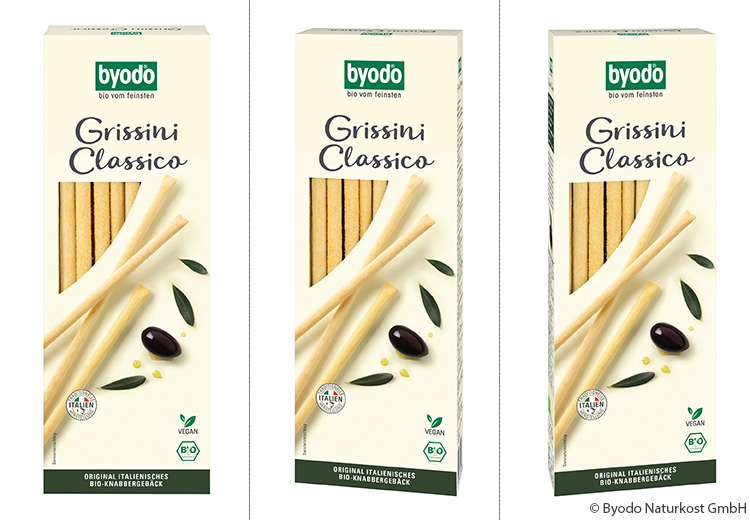
When it comes to product presentation, it is therefore not only the content that is decisive, but also the packaging. Often one does not work without the other.
In a classic product shoot, the packaging is usually photographed as well. But what happens when the packaging is given a new design? Or a product is offered in different countries and the packaging is therefore available in different languages? Photographing each variant individually and then editing it? Much too time-consuming. Here is a better way.
Digital Packaging Mockups. In principle, a digital replica of the packaging of a product. A dummy of the product is created from a PDF file and photos, onto which the packaging design is then “placed”. Like this, a digital image of the packaging is created, from which in turn the perfect product image is created.
Let’s take a closer look at how exactly this works using the products and packaging of our customer Byodo Naturkost.
Byodo: Fine organic foods in optimal packaging
For over 35 years, Byodo Naturkost GmbH has been successfully offering a wide variety of products made from 100% organic ingredients. The diverse product range includes various vinegars, oils and sauces, Italian pasta as well as numerous desserts, baked goods and snacks.
At Byodo, it is not only high-quality, organically produced products that come first. A lot of value is also placed on sustainable packaging options for the products. Protection from external influences and thus good quality for a long time, visually appealing and practical as well as ecologically sustainable. This is the optimal packaging for Byodo.
And since the existing product range is always being expanded or new designs ensure a fresh appearance, product images with new or updated packaging are always needed. For the creation and adaptation of the packaging mockups as well as the final product images, Byodo relies on the high-quality work of Br24.
The material for packaging mockups
In most cases, the packaging layout for a product is available as a PDF file, referred to as a final artwork PDF or packaging PDF. This PDF shows the complete design of the packaging and often contains further information such as dimensions or colour specifications.
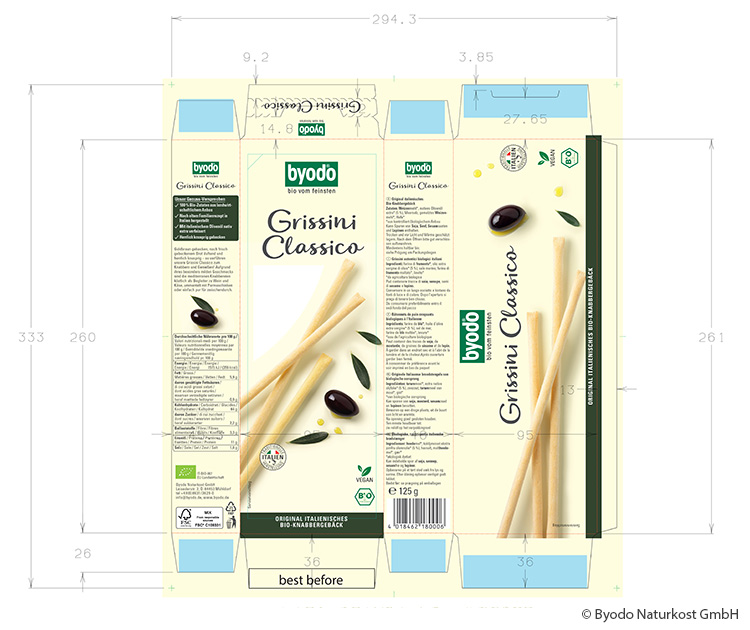
In addition, photos of the original product are necessary, that means the product in its original packaging. On the one hand, the photos show what the product and packaging look like in reality. On the other hand, they serve as the basis for the dummy to be created. We will come to this in detail in a moment. When it comes to image quality, the better the photos, the better for further processing. What is absolutely important to note: The product photos supplied determine the perspective for the final result. This means that they must be taken from the perspective in which the final product image is to be created.
Depending on the type of packaging, we may also need a separate photo of the pack contents without the packaging. This is often the case, for example, with packaging with a viewing window or transparent pouches through which the contents inside can be seen. Like the crispy bread packaging from Byodo, for example.
Creating the dummy
The first and at the same time most important step in the entire process: the creation of a packaging dummy using the provided product photos. Now it becomes clear why the photos have to be taken in the desired perspective. Because the creation of the dummy is based on the photos of the original product. Since we work completely in 2D, each dummy shows the product from only one perspective. If a different perspective is to be shown, another dummy must be created. We will explain in more detail later why we work in 2D.
The dummy is basically a “naked” or bare replica of the product, that means without layout and design. This may sound simple at first, but it is actually the most time-consuming step. Because it is not enough, for example, to just create a simple rectangular shape for a pasta package. In order for the dummy and later the final result to visually correspond to the real packaging, different retouching and editing steps have to be carried out.
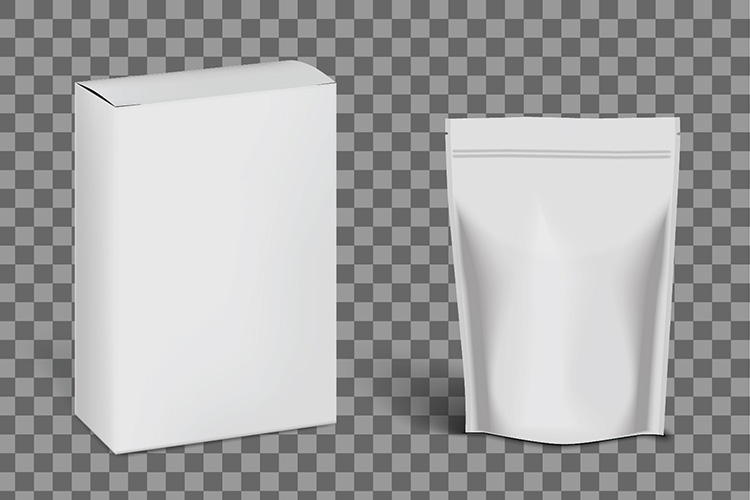
This includes, among other things, the matching of the form as well as the creation of surface structures. The integration of light reflections and shading, taking into account the interplay of light and shadow. Some packaging, such as bags or foils, have kinks or dents due to their characteristics. All this has to be accurately transferred to the dummy in order to obtain a mockup that is as realistic as possible. Detail work, a careful eye and a steady hand are required here.
The dummy created serves as the basis for the finished product and the packaging design, which is available as a PDF.
Integrate the packaging design into the dummy
In the next step, the final artwork PDF of the packaging is incorporated into the dummy. To do this, the PDF is first divided into the individual parts of the packaging, for example each side of the packaging. Then each part of the packaging is placed separately on the dummy.
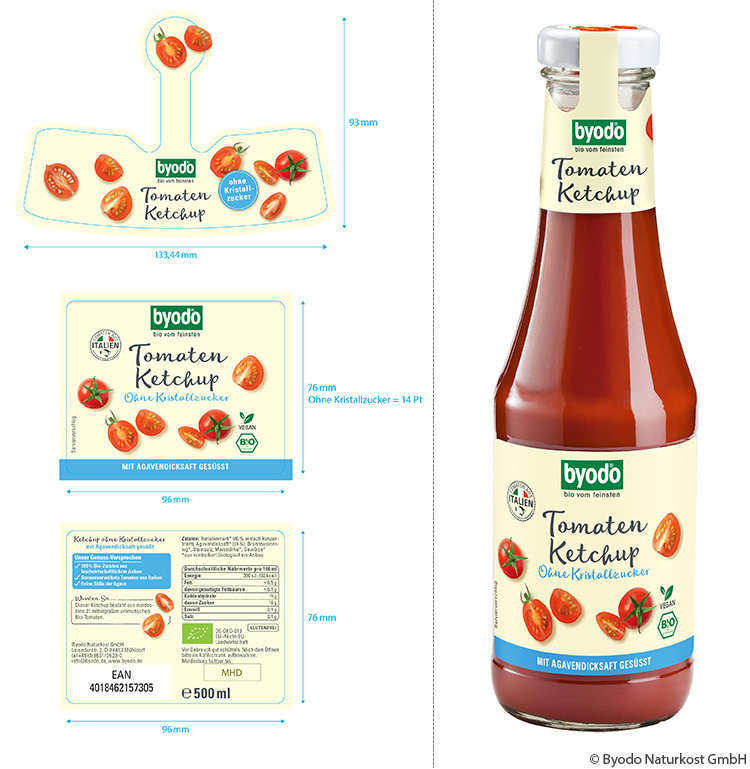
When editing, attention must be paid to perspective distortions, curves, corners and edges as well as kinks, but also reflections and shadows. After all, the result should look as realistic as possible. Automatic distortion tools are helpful in some cases, but do not always deliver satisfactory results. For precision, therefore, manual work is usually required.
For packages that have, for example, a viewing window, such as Byodo’s crispy bread, a photo of the contents is inserted separately in the packaging PDF. By integrating shadows and further processing, it is later no longer recognisable that two images have been joined together. And both the packaging and the contents look perfect.
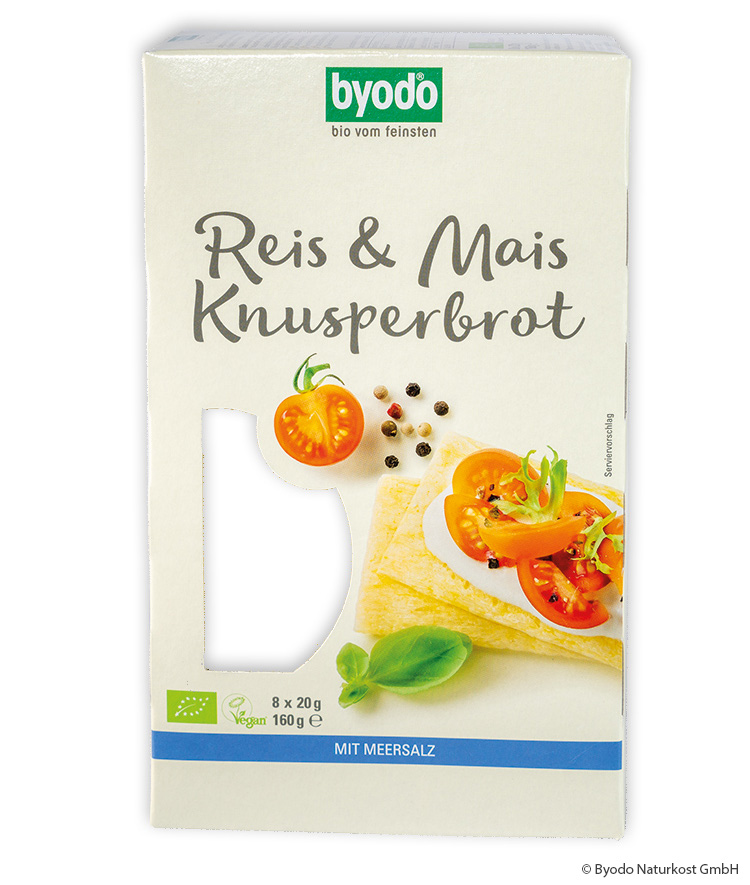

On many packages, information is depicted that must be present on the real product but should not be included in a product image. This includes, for example, barcodes (EAN codes), a designated space for the best-before date or, in the case of food images, the text “serving suggestion”. Often, such information is removed.
The advantages of packaging mockups
Once a dummy has been created, it can be used again and again. The basic packaging (type, shape, size, etc.) and thus also the dummy does not change that often. What does change, however, or is available in different variations, is the design of the packaging. For example, in the case of different flavours and language versions or a new packaging design. In such cases, the dummy can be adapted solely with the help of various final artwork PDFs.
If, for example, the type of packaging changes, existing dummies can be adapted and used depending on the extent of the changes. Or in the case of fundamental changes, a new dummy is created. However, since the creation is done in 2D, the effort is reasonable compared to a 3D creation.

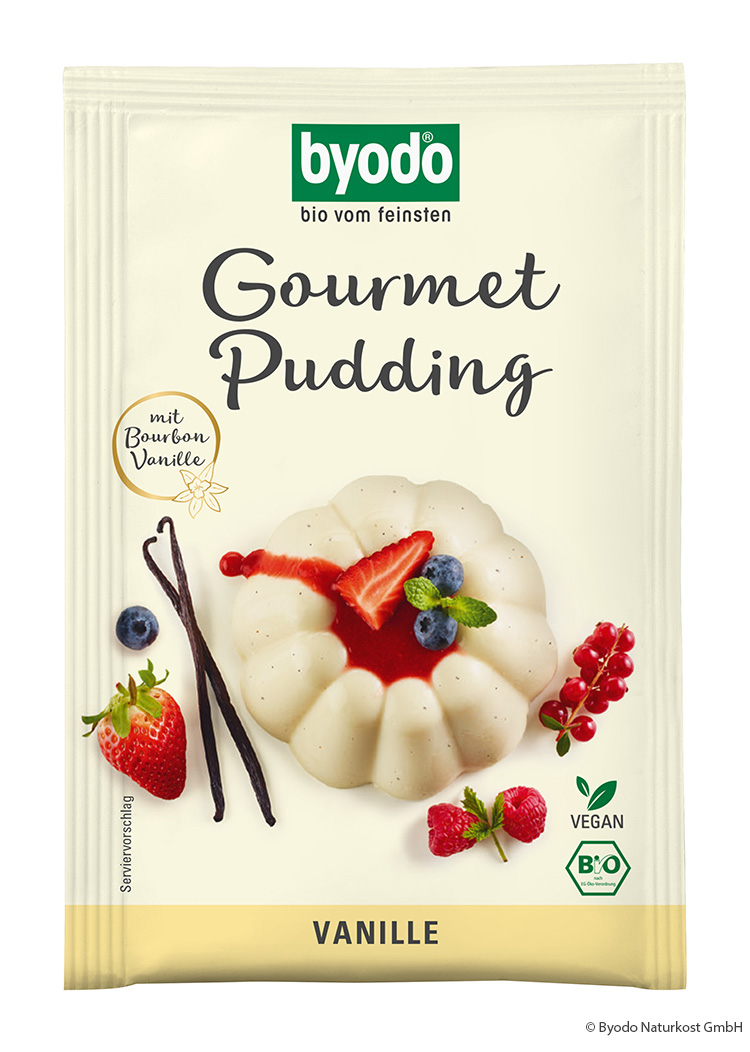
Why do we actually work with 2D? When it comes to digital packaging mock-ups, the terms 3D and CGI usually come up first. Quite simply, it is the cost-effective and quick alternative to 3D/CGI creation. A 3D dummy may seem more flexible at first glance, after all, a product and also packaging can be shown in 3D from every conceivable angle. For some products this also makes sense. But in most cases this is not necessary at all and one perfect view is enough. Effort and benefit are then out of proportion with 3D. So the creation in 2D is an alternative that brings (almost) the same benefit with less effort and costs.
We put your packaging, products & more in the spotlight!
Professional packaging mockups and image editing for product photos of the highest quality.
For more information, samples and detailed prices download our e-commerce & product images portfolio.
- 2023
- January (1)
- 2022
- December (2)
- November (1)
- October (2)
- September (2)
- August (1)
- July (1)
- June (1)
- May (1)
- April (1)
- March (1)
- February (1)
- January (3)
- 2021
- December (2)
- November (1)
- October (3)
- September (2)
- August (1)
- July (3)
- June (1)
- May (2)
- April (1)
- March (1)
- February (2)
- January (4)
- 2020
- December (2)
- November (3)
- October (4)
- September (1)
- August (2)
- July (1)
- June (2)
- May (3)
- April (3)
- March (3)
- February (4)
- January (4)
- 2019
- December (1)
- November (2)
- October (5)
- September (1)
- August (3)
- July (2)
- June (2)
- May (3)
- April (2)
- March (3)
- February (2)
- January (4)
- 2018
- December (2)
- November (2)
- October (3)
- September (3)
- August (2)
- July (2)
- June (2)
- May (1)
- April (1)
- March (2)
- February (3)
- January (2)
- 2017
- December (2)
- November (2)
- October (1)
- September (1)
- August (1)
- July (1)
- June (1)
- May (1)
- April (1)
- March (1)
- February (1)
